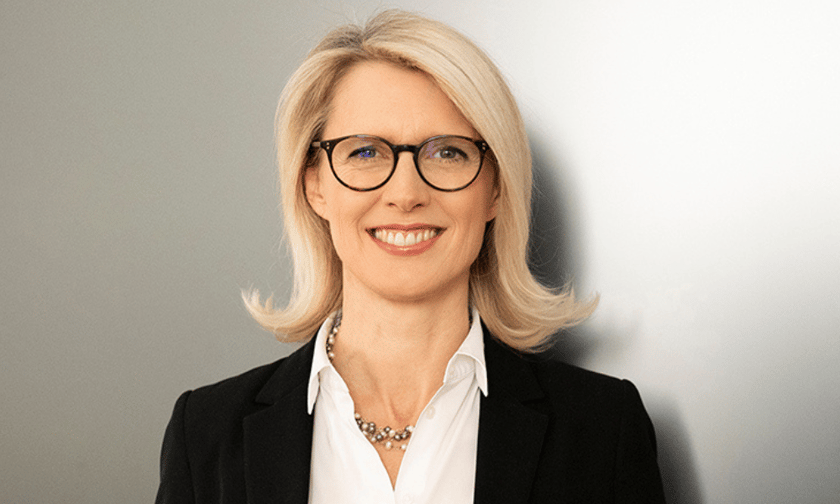

“We are not willing to be challenged on the reset we operated in 2022 and 2023 with clients, when it comes to higher attachment points, when it comes to more clear wordings and when it comes to the prices we have achieved. It’s important to us that we keep this balance, and it’s also all the more important that, in some places, we still have further adjustments to conduct.”
At a media briefing during the 2024 Baden-Baden Reinsurance Meeting, Munich Re’s Clarisse Kopff (pictured) affirmed its commitment to supporting the market in coping with dynamic conditions, “provided there is a fair sharing of risk between policyholders, the insurers and the reinsurers”.
Today’s risk environment is constantly changing, and that pace of change has accelerated, which is visible in all lines of business, said Kopff, who leads European and Latin American reinsurance at Munich Re. It’s visible in property, which has seen an increase in both the frequency and severity of natural events. It’s visible in casualty, which has faced large swings in inflation and interest rates, as well as emerging risks including social inflation, AI liability and ‘forever chemicals’ such as PFAS.
It’s a constant story of keeping up in expertise, in modellng, and in pricing, and it’s a balancing act that Munich Re has proven effective at navigating. Kopff attributes that to a range of factors including the reinsurer’s constant investment in its people and its models, and the fact that it looks to be well-reserved at any point in time.
“We like to have a strong balance sheet,” she said, “and buffers on the balance sheet to be able to face the unexpected, and then make sure we have a broad diversification in lines of business and in geographies. Because of that, and because we are large and because we are strong financially, we can be a predictable and consistent capacity provider to our clients across the cycles.”
Exploring the impact of the increasing frequency and severity of nat-cat activity further, she highlighted that the US$100 billion insured loss marker has been exceeded on a regular basis in recent years. It’s still too early to say whether 2024 will continue the trend, she said, but the ongoing US hurricane season is intense.
To add to this, the global risk environment is marked by geopolitical fragility with two ongoing wars, increasing tensions between the Western world and the rest of the world, and increasing civil unrest. Meanwhile, cyber threats and disruptions are also increasing, she said, with CrowdStrike an example of how even non-malicious events can provoke large-scale business interruptions.
Looking at the supply and demand dynamics at play in the market, Kopff noted that supply has been moderately increasing, largely from retained earnings. However, she said, there’s not a huge number of new entrants coming into the market with the ILS market for Europe not significant either. “It's very likely that potential new patrons are now adopting a wait-and-see approach, waiting to see how the hurricane season unfolds.”
On the other side of the equation, there is clearly increasing demand, driven by homeowners’ awareness of the need to protect their assets from natural events. Demand is also increasing in motor, amid growth from original market rates and demand for capital relief solutions. In cyber, increasing demand is stemming from awareness of headline-making events such as CrowdStrike.
“In all lines of business, actually, we see good demand, strong demand, and we are happy and ready to accommodate it, provided the terms and conditions we get adequately reflect the risk that we are taking,” she said.
She highlighted how consistently insured market losses have been increasing in Europe in the last four years. These are predominantly non-peak peril losses including flash storms, hail, floods and, in some economies, wildfires.
Munich Re is committed to doing its part for the market, Kopff said, which can be seen from how it has increased capacity when terms and conditions are met. The business wants to actively participate in helping to close the protection gap, which still remains significant worldwide with two-thirds of economic losses still uninsured.
Efforts to narrow that gap start with awareness, even before considerations about affordability, she said, with homeowners needing to be educated about insurance. Public authorities are supporting efforts to raise awareness, with some territories now considering making insurance compulsory if it wasn’t before.
But even beyond awareness, there needs to be an effective risk transfer mechanism in place to create a sustainable market, where everybody carries their fair share of the risk. “Then the risk that is actually transferred needs to carry a proper price that reflects the risk that it is behind,” she said. “And then the last [consideration]… is we need to keep up the dialog we have with public authorities to actually work on prevention measures.
“And the state has a lot to do there, on building dams, on strengthening building codes, on zoning, and so we want to keep this dialog alive so that this prevention is actually happening,. Because this is a condition for making insurance, in the long term, not only affordable, but available at all.”
